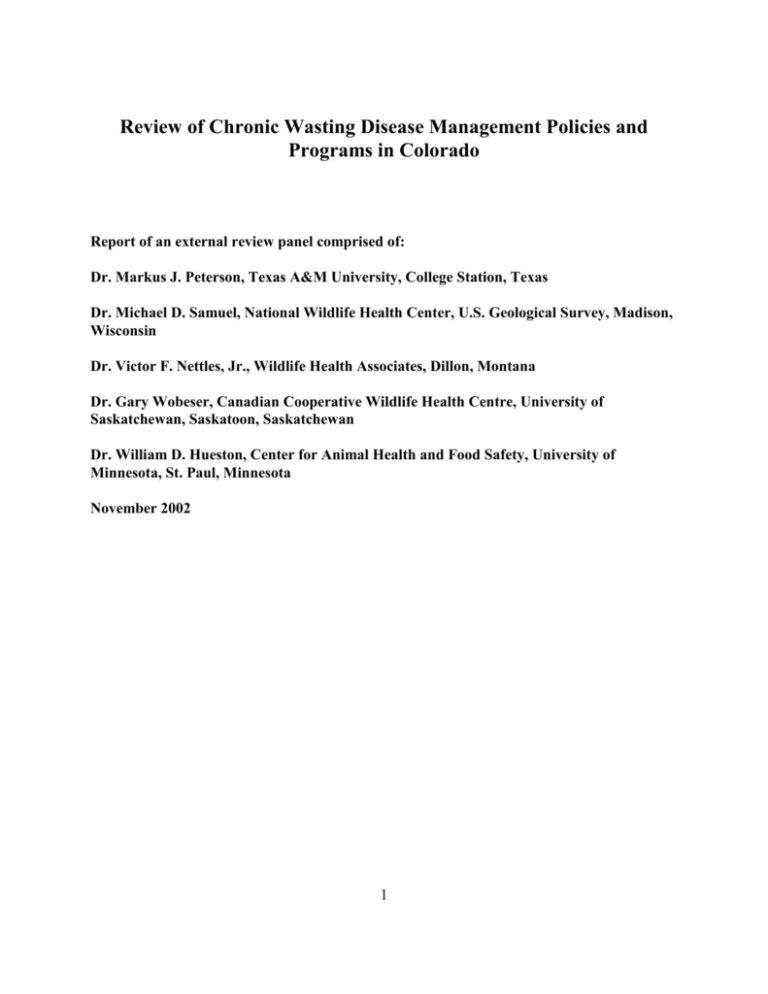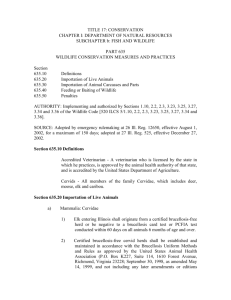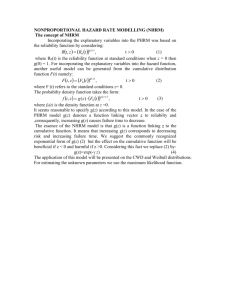Word Document - Chronic Wasting Disease Alliance
advertisement

Review of Chronic Wasting Disease Management Policies and Programs in Colorado Report of an external review panel comprised of: Dr. Markus J. Peterson, Texas A&M University, College Station, Texas Dr. Michael D. Samuel, National Wildlife Health Center, U.S. Geological Survey, Madison, Wisconsin Dr. Victor F. Nettles, Jr., Wildlife Health Associates, Dillon, Montana Dr. Gary Wobeser, Canadian Cooperative Wildlife Health Centre, University of Saskatchewan, Saskatoon, Saskatchewan Dr. William D. Hueston, Center for Animal Health and Food Safety, University of Minnesota, St. Paul, Minnesota November 2002 1 Executive Summary Chronic Wasting Disease (CWD) has been recognized in free-ranging cervids in Colorado since 1981, but how long it has been present or how it arose are unknown. More is currently known about the distribution and ecology of the disease in Colorado than in any other jurisdiction in North America. The Colorado Division of Wildlife must be commended for their leadership and diligence in investigating the disease, and for providing information and education about CWD to the public. There is little experience from elsewhere that can be used to guide management of this disease. In fact, efforts made by the Colorado Division of Wildlife serve as models for other wildlife regulatory agencies. The disease is significant because it decreases the perceived value of wild cervids, is a mortality factor that may impact cervid population dynamics, it can be spread to new areas through human activities, and there is no evidence that CWD will spontaneously disappear or be controlled without management intervention. Because there is little scientific knowledge about many aspects of CWD ecology, attempted intervention is certain to be controversial. Thus, management of CWD must be experimental and adaptive; it must integrate research, management, and surveillance programs to enhance the capability to control this disease. The best available scientific information should be used to plan management actions, and these programs must include methods for assessing the effectiveness of each aspect of the management plan. As new information becomes available, and as results of intervention activities are assessed, management techniques should be adjusted or replaced accordingly. The effectiveness of management can only be assessed based on changes in distribution and prevalence of the disease. For this reason, rigorous on-going surveillance must be an integral part of any CWD management plan. The Colorado Wildlife Commission policy on CWD provides a suitable framework for management of the disease based on two objectives: 1) minimizing spread of the disease and 2) reducing prevalence in endemic areas. The goals of these objectives are to contain the disease and to reduce potential population impacts within the endemic areas. However, based on recent disease recognition on the western slope of Colorado (and in other states and provinces), it seems likely that new disease outbreaks will be discovered. Therefore, a third objective of eliminating the disease, when it is found outside the endemic area, also should be included in the policy. This objective should be coupled with a rigorous surveillance program for early detection of disease in new areas. General written management plans should be developed that describe the management options available for use in various situations. In addition, these plans should include their rationale and the methods that will be used to assess the effectiveness of management. These general plans would form the basis for detailed management plans at the Data Analysis Unit or Game Management Unit (GMU) level. Methods that have been developed for CWD surveillance in endemic areas are generally suitable; however, more emphasis should be placed on collection of spatially explicit data that can be used to better define the apparent clumped distribution of the disease. Surveillance must be continued over time and sample sizes must be sufficient to detect changes in prevalence and distribution of the disease. Surveillance methods for effectively monitoring CWD-free areas to 2 provide reliable early detection of disease and for determining the spatial distribution of disease need further development for use in Colorado and in other jurisdictions. An important adjunct to surveillance is continued research to define biological population units of deer and elk and to delimit their annual and seasonal distribution. Use of hunter-killed animals should be continued as a primary method of surveillance, but it is important that the Division have the authority to conduct intensive collections where inadequate samples are available from hunters and if infected animals are discovered outside the endemic areas. Immunohistological testing of brain tissue should remain the standard for identification of infected animals until better or more rapid tests are developed and validated. Immunohistologic testing of tonsil and retropharyngeal lymph nodes is suitable for deer, and can be valuable in determining early infection status. However, these tissues lack sufficient sensitivity to detect infected elk. The Division should collaborate with other agencies to develop new, more rapid diagnostic tests. These must be validated through comparison with inmmunohistology before being used diagnostically. The Division should not become involved in provision of routine diagnostic tests for CWD except as required for management and research purposes, but should develop procedures to obtain all diagnostic results at no cost and in a timely manner from other laboratories that test for CWD in wild cervids in Colorado. The Division of Wildlife has been a leader in research on CWD in wild cervids since the discovery of the disease. Research staff within the Division should be commended for the quality and number of scientific publications on CWD; Division policy should encourage the publication of research results to increase the scientific knowledge on CWD and to assess management programs in Colorado. It is anticipated that additional new resources will become available that will enhance the Division’s involvement in CWD research. The Panel strongly recommends that these efforts target knowledge required for disease management in free-ranging cervids in Colorado. This should include the influence of animal density, demography, movement, and behaviour on distribution of the disease, methods of transmission, persistence of infectivity in the environment, and characterization of “hot spots”. New information on spatial distribution, transmission dynamics, population density, and demography should be used to update models of disease ecology. Colorado should work with other jurisdictions to develop coordinated studies of the epidemiology of CWD and of the effectiveness of various management approaches in different physiographic regions. As discussed earlier, management of CWD in wild cervids must be experimental and adaptive, because of scientific uncertainties associated with the disease. Regulations preventing movement of live animals from endemic areas and feeding or baiting of cervids should be continued. Regulations should be developed to control the movement of carcasses and parts of cervids from the endemic area and to provide for safe disposal of these materials. Clinically affected animals should be removed as part of surveillance. Experimental population reduction in GMU 9 should be completed and, if possible, replicated in at least one additional site to allow more rigorous comparison of the relationship between cervid density and CWD prevalence. It also is reasonable to cull animals in “hot-spots” to reduce potential exposure, and environmental contamination, as well as to collect information on the precise distribution of affected animals. Plans should be developed for the management of CWD cases recognized outside known endemic areas. Live capture and marking, testing, and culling of infected individuals may be 3 useful for research purposes in areas where hunting and or random culling is not feasible. However, this approach is expensive and has limited potential as a management tool. The Colorado Wildlife Commission must be credited for making effective education and communication with the general public about CWD a top priority, and particularly for providing scientific information on CWD to the public and to individuals who may wish to hunt in endemic areas. The panel believes that it is appropriate for the Division to maintain an active working relationship with public health experts in matters related to human health and safety and to work with these health experts to develop accurate education materials regarding risk so that science remains the major determinant of policy. The Division should work with other agencies to ensure that services are available for hunters who wish to have harvested animals tested for CWD. 4 Introduction In May, 2002, the Colorado Division of Wildlife formed an external panel to review the Division’s activities related to Chronic Wasting Disease (CWD) in free-ranging cervids in Colorado. The panel, composed of Dr. Markus J. Peterson, Texas A&M University, College Station, Texas; Dr. Michael D. Samuel, National Wildlife Health Center, U.S. Geological Survey, Madison, Wisconsin; Dr. Victor F. Nettles, Jr., Wildlife Health Associates, Dillon, Montana; Dr. Gary Wobeser, Canadian Cooperative Wildlife Health Centre, Saskatoon, Saskatchewan; and Dr. William D. Hueston, University of Minnesota, St. Paul, Minnesota was charged with offering comments and criticisms on all aspects of the policies and management actions related to CWD. Chronic Wasting Disease is a recently recognized disease of some North American cervids (elk, mule deer, white-tailed deer). The disease was first recognized in free-ranging cervids in 1981, and since the 1960s in captive cervids, but the actual length of time that the condition has been present in North American cervids is unknown. The overall distribution of the disease in North America is largely unknown, because adequate sampling and surveillance have not been conducted in most areas of the continent. Currently, it is impossible to draw firm conclusions about the origin(s) of CWD, or the relationship among the various sites where the disease has been recognized. In some situations, it is clear that the disease was introduced into new regions through translocation of captive cervids. More is known regarding the distribution and prevalence of the disease in wild cervids in Colorado than in any other jurisdiction in North America. The Colorado Division of Wildlife must be congratulated for their far-sightedness and diligence in investigation of this disease problem while it was still considered to be of little or no significance by wildlife managers elsewhere. It is necessary to address the need for active management or intervention in response to CWD in wild cervid populations, because controversy is inevitably associated with active management of wildlife. Arguments in favour of active management include that: presence of the disease is undesirable in wild cervids managed for hunting, viewing, or other recreational purposes. based on current scientific information about the disease, CWD may have a substantial negative impact on cervid populations. there is significant potential for expansion of the geographic range of the disease. human activities, particularly translocation of animals, have resulted in CWD range expansions. once established, the disease may be maintained through environmental contamination for an unknown period of time. The presence of CWD in cervids (wild and captive) is considered undesirable for several reasons. The most important is that CWD is a form of Transmissible Spongiform Encephalopathy (TSE). The TSEs are a group of similar diseases that includes Scrapie of domestic sheep, Bovine Spongiform Encephalopathy (BSE) of cattle, and Creutzfeld-Jacob Disease (CJD) in humans. BSE has been associated with variant CJD in humans. There currently is no evidence that CWD represents a risk to human or domestic animal health, but because there are many unknowns regarding TSEs, it must be considered undesirable for cervids with CWD to have potential 5 contact with humans and domestic animals. Because of the uncertainties regarding CWD, this disease considerably diminishes the perceived social and economic value of the wild cervid resource. A second reason CWD is undesirable is that it is a cervid mortality factor that could potentially reduce cervid density in populations where the disease is endemic. Evidence from outbreaks of CWD in captive cervids indicates that the disease can be translocated and become established through movement of “infected”* animals. CWD is established, and has been present in certain areas of Colorado for some time, but based on sampling to date, it has recently been detected on the western slope of the state. Thus, there is potential for the disease to expand its range in the state by natural dispersal and movement of free-ranging cervids or through translocation of animals. Although research studies are still being conducted, preliminary evidence indicates that environmental contamination may play a role in transmission of CWD to cervids in captivity. At present, information is inadequate to understand the role of environmental contamination in disease transmission and persistence. Arguments against active CWD management include that: the disease is a natural phenomenon, and as such, should not be interfered with. the disease may be of no significance. the disease will “burn itself out” if left alone. natural disease resistance will develop over time within the endemic populations and management may impede this process. there are so many unknowns regarding CWD that management is impossible, or at least impractical. The first of these arguments cannot be answered completely, because the origin of the disease is unknown. There is evidence, however, that CWD is expanding its geographic range and that humans have facilitated this process. Thus, it cannot be considered an entirely natural process. Also, wild cervids live in highly manipulated environments in which some natural processes may not operate. The significance of the disease as a factor driving cervid population dynamics is unclear, but the Colorado Division of Wildlife has preliminary evidence of decreased adult survival in areas where CWD is established and of increasing prevalence in endemic areas over time. These data support model predictions that the disease will increase in frequency of occurrence and will significantly impact populations. Regardless of these factors, the disease is of significance because of public concerns about TSEs in general and perceived risks to humans and domestic animals. It is difficult to determine circumstances under which CWD might “burn itself out”, because there are no documented instances in which the disease was introduced but failed to establish. At present, the best available evidence from Colorado and Wyoming indicates that in the absence of management intervention, CWD will increase in prevalence and distribution among susceptible cervids. There is no evidence at present of genetic resistance to CWD within mule and white-tailed deer, although this has not been studied extensively. If it exists, genetic resistance might spare individuals in wild populations, but it is unclear that it would have a significant protective value at the population level, at least in the short term. The ____________________________ * The terms infected, infective, infectious, and infectivity are used in relation to animals with the abnormal prion protein in their tissues associated with CWD In strict terms, this usage is incorrect because the causative factor is believed to be a non-living substance. The usage, however is appropriate because the disease behaves in a contagious manner, spreading from animal to animal in a manner analogous to that of a living agent. 6 potential advantages of genetic resistance probably would be reduced because of the chronic nature of the disease. Animals that die of CWD are adults, and most have reproduced one or more times prior to death. Thus, because of the age structure of these populations, susceptible genes would be passed to future generations before the animals become clinically ill with CWD. This situation in wild cervids stands in contrast to Scrapie in domestic sheep, where farmers have the option to manipulate the genetic structure of the herd. Because of the many scientific uncertainties regarding the basic biology and ecology of CWD, management must be considered experimental. However, this cannot be taken as an argument for waiting for new research or for doing nothing. Because CWD behaves, in general, in a manner similar to some infectious diseases, it is reasonable to expect that management techniques used for chronic, late-onset infectious diseases might be appropriate, in the absence of direct information. Evidence from endemic areas of Colorado and Wyoming indicates that the result of no intervention is increased prevalence and distribution of the disease. The best available scientific information should be used to plan and conduct management within an adaptive framework. In this approach, the process must include methods for assessing the effectiveness of the management actions in controlling disease. As new research information becomes available, and as the results of current management actions are assessed, techniques should be adjusted or replaced. The effectiveness of management actions must be assessed primarily on changes in spatial distribution and prevalence of CWD in free-ranging cervids. For this reason, intensive surveillance must be an integral part of any disease management plan. Effective management requires clearly defined goals and must operate within a suitable policy framework. The policy framework provided to the panel was “Colorado Wildlife Commission Policy, Subject: Chronic Wasting Disease Approved September 13, 2001”. The Commission’s policy statement should provide a firm foundation for future action, including development of adaptive management plans designed to deal with CWD within known endemic areas and should it be discovered outside the current endemic area. Two objectives for disease management are stated in the document: 1. to minimize the potential for CWD to spread beyond the currently infected areas of the state. 2. to reduce the level of incidence within the endemic areas. The CWD external review panel recommends a third objective: eliminate the disease when it is found outside the endemic area. General, written management plans should be developed that describe the management options available for use in various situations, together with the rationale providing the foundation for each option, as well as the methods that will be used to assess the effectiveness of each management strategy. These general plans would form the basis for detailed management plans at the Data Analysis Unit or Game Management Unit level. Surveillance Program The objective of surveillance is to collect information necessary for early detection of new disease foci, to determine the distribution and prevalence of CWD in established areas, and to monitor trends in these factors for research and management. The current and past surveillance 7 programs have identified areas where the disease is established (endemic areas), identified new foci, and provided a level of assurance that the disease is not present in other areas of the state. More is known about these aspects of the disease in Colorado than in any other jurisdiction in North America. A shortcoming of the current surveillance program is the lack of spatially explicit information on the collection of some individual animals. This is critical because of the apparent clumped distribution of the disease within the endemic area and of new disease foci. This clumped disease distribution necessitates more intensive sampling than if it were distributed uniformly, because these “hot spots” could be missed entirely if sampling rates are insufficient. To be effective as a management or research tool, surveillance must be continued over time and sample sizes should be adequate to detect change. An important framework for surveillance is continued research to define biological populations of deer and elk and to delimit their annual and seasonal distribution. This information is necessary to better understand the interaction between cervid and CWD ecology and to identify appropriate population units for CWD surveillance and management. The general pattern of surveillance has several components: - Collection and examination of clinically ill animals: This is regarded as a useful approach to detect new foci of infection; however, the sensitivity of this method is unknown and probably quite low because the number of animals with clinical signs may be small. Removing clinically sick animals from the population is a reasonable strategy, because animals with clinical CWD will die shortly and may be important sources of infection for susceptible animals. This form of surveillance depends upon the public and Division field personnel to report and collect sick animals. Techniques to enhance or encourage this form of surveillance should be implemented, particularly outside the known endemic areas. These data, by their very nature, would be spatially explicit. Better information is needed about the sensitivity of the method for detecting new disease foci; in the interim, this method should be considered as supplementary to other surveillance programs. - Surveillance within endemic areas: The plan presented to the panel was to conduct annual sampling of deer herds, while sampling elk herds at 5-year intervals, in the endemic areas. This would be done through “random sampling” based primarily on hunter-killed animals, supplemented by Division personnel culling animals to provide adequate sample size. (The ability to use Division staff to remove animals for research is included within the CWD policy statement promulgated by the Commission, and is important for effective surveillance in areas where the hunter-killed sample is inadequate.). Previous information from hunter-killed animals was inadequate for detailed spatial analysis. The panel strongly recommends this be improved, because available information indicates that CWD is not distributed uniformly on the landscape, so that it is critical to identify foci of greater prevalence (“hot spots”) and relate these to ecological factors associated with cervid populations (e.g., social groups, movements and habitat features). Two suggestions made by the panel were: 1) provision of signs displaying gridded maps at collection sites to improve the quality of spatial information provided by hunters, and 2) it should be made clear to hunters that test results will only be available from animals for which complete information is provided. It will likely be necessary that Division personnel collect additional animals to precisely define CWD foci within the endemic areas. The objectives for 8 surveillance programs and the sample sizes required to detect changes in density and prevalence, need to be clearly identified for each area of interest. - Surveillance outside the endemic areas: Emphasis should be placed on surveillance in high-risk areas and economically important herds; however, there is considerable need to determine and quantify specific risk factors. In the interim, intensive surveillance should be conducted adjacent to endemic areas and in areas likely to be affected by movement or dispersal from infected herds. In these areas, sampling currently is planned to be at a level sufficient to detect 1% prevalence of disease within the population. This is an appropriate step toward determining the general distribution of the disease in the state. In the future, this program should be augmented by systematic sampling from individual units not considered to be at increased risk, using a similar rate of sampling. Sampling of cervids dying due to severe winter conditions might be another opportunistic method of increasing sample size and defining the spatial extent of areas sampled throughout the state. - Surveillance about newly discovered foci: It is important that the Division retain the authority to conduct intensive collection of animals if infected cervids are discovered outside the endemic areas. The purpose of this “epidemiological culling” would be to define the extent and distribution of CWD in the affected area to provide public information and to evaluate alternative management actions. Diagnostic Testing The current “gold standard” for identification of infected animals is immunohistologic testing of brain tissue. Use of immunohistologic testing of tonsil and retropharyngeal lymph nodes also is appropriate for deer, but is inadequate to detect infected elk. All newly developed tests must be validated through comparison with inmmunohistology, so that data collected by different methods are comparable. The Division of Wildlife should concentrate on using the most appropriate tests on samples required for surveillance or research purposes. The Division should not become involved extensively in the provision of routine diagnostic tests for CWD other than those required for surveillance, management, and research. The Division should encourage other laboratories or agencies to develop validated test procedures where hunters could submit specimens. When testing for CWD in wild cervids is done by other agencies, the Division should develop the necessary relationships to obtain all results that may be useful for surveillance/management in a timely fashion and at no cost to the agency. The Division should cooperate and collaborate with other agencies in the development and validation of new diagnostic tests, particularly highly sensitive, rapid screening tests, antemortem tests, and tests of environmental samples. Understanding the Disease: Epidemiology and Research The Division of Wildlife has taken a leading role in research related to understanding the ecology of CWD in wild cervids. The likely provision of new resources provides an opportunity for greater involvement in research. Research should be directed toward identifying knowledge required for effective surveillance and management of CWD in Colorado. Research areas that 9 should be addressed include the influence of animal density on prevalence and transmission of the disease, the effect of animal movement and behaviour on transmission and spatial distribution of the disease, methods of transmission, genetic susceptibility, persistence of infectivity in the environment, defining the risk factors associated with geographic areas where clusters of CWD are found (“hot spots”), and the interaction of demographic factors, including sex and age distribution, with the disease. The panel did not review animal infection experiments that have been and are being conducted by the Division of Wildlife. As new information becomes available from surveillance, experimental research, and management, models of disease ecology and transmission should be updated to include spatial, cervid density, and demographic information. Because Colorado has taken the lead in research and management related to CWD, it is important that Division personnel continue to participate and work cooperatively with other states and provinces investigating the disease. There may be important opportunities for comparative studies in different locations regarding research on CWD epidemiology, related cervid ecology, and the effectiveness of management activities—particularly population— reduction, in reducing prevalence of the disease in an array of physiographic regions. Management of the Disease Intervention to control CWD in wild cervids must be experimental and adaptive in nature, because management has not been attempted elsewhere; there are no established protocols or proven solutions. Further, management techniques developed for other TSEs may not be appropriate for CWD in free-ranging cervids. Surveillance and management activities are inseparable, because assessment of the distribution and prevalence of the disease is the only available measure of management success. Management actions and surveillance must also be based on the best available scientific information. Because of the many uncertainties about CWD, it is reasonable to extrapolate to some degree from methods that have been used for other chronic diseases. Management of CWD is based upon several key assumptions: (1) the disease is transmitted from affected to susceptible animals, i.e., it is contagious. The route of transmission in nature is unknown, but there is sufficient evidence from captive animals to establish its transmissibility. (2) high animal density and frequency of contact are associated with increased incidence of infection. There are no data available linking animal densities to transmission rate in the wild, but extremely high prevalence has been observed under captive conditions, suggesting that transmission may be density dependent. (3) the disease is limited to cervids, but probably can be transmitted among elk, mule deer, and white-tailed deer. The significance of this fact is that all three species (both wild and captive) must be included in any management plan where these species are sympatric, while other wild and domestic species need not be considered as sources of the disease or as potential victims. This means that the CWD can be managed within cervid populations. 10 Implemented or proposed management strategies include: - regulations to prevent translocation of live animals from known endemic areas: This is reasonable to prevent dissemination of the disease and should be continued. - regulations to prevent feeding and baiting of cervids: This is a reasonable approach for reducing contact among potentially infected and susceptible animals and the potential for environmental contamination and should be enforced. Feeding also might artificially increase population density. The Colorado Division of Wildlife or private parties should not use feeding as a management strategy in severe winters. - regulations to prevent the removal of carcasses or parts of cervids from the endemic areas: It appears that the highest level of infectivity is in nervous system and lymphoid tissues. Regulations should be developed to control movement of these materials from the endemic area and to provide for safe disposal of these tissues within this region. With this in mind, research designed to determine the relative risk to wild cervids of disposal of offal and bones in landfills is needed, as other safe disposal methods are costly. - removal of clinically affected animals: These animals must be regarded as potential sources of infection and should be removed, tested for CWD, and disposed of safely. - population reduction within endemic areas: The stated Division management goals are to limit the distribution of CWD and to reduce prevalence to <1% in each Data Analysis Unit, and to <2% in each Game Management Unit (GMU). The feasibility of these objectives is unknown. The rationale for these prevalence levels is based on predictive models. This rationale should be included as part of the educational program that will be necessary as part of any population reduction program. The degree of population reduction required to reduce transmission of CWD is unknown. Division personnel proposed to stabilize populations in endemic areas except for in GMU 9, where the goal is to reduce the population to 50% of previous density and maintain it at that level. This experiment must be maintained for several years in order to determine if there is any influence on the CWD prevalence. This experimental approach to disease management should be continued and, if possible, replicated in at least one additional management unit to allow more adequate evaluation of the relationship between cervid density and CWD prevalence under natural conditions. Intensive surveillance will be required in both the population reduction and appropriate control areas. - culling of specific subpopulations: Data accumulated through surveillance indicate that disease prevalence is clustered in foci or “hot spots”. As the nature of these foci is defined, it is reasonable to direct culling toward these areas to reduce potential exposure to cervids in surrounding habitat as well as to collect ecological information on the precise distribution, genetic relationship, and social interaction of affected animals. Other methods that have been proposed or suggested include: - live capture, testing and culling of infected animals: This technique, using live capture, tonsillar biopsy, and radiotelemetry to follow animals after release, with recapture and killing of test-positive animals, may be appropriate as a research tool to collect information on distribution and prevalence of CWD in areas where public hunting and/or culling is not feasible, such as suburban areas or in certain National Parks. Test and slaughter of this type, however, has limited 11 potential as a management tool and is not feasible over broad areas. It might be useful in local situations, however, where extra funding could be obtained from sources other than the Division of Wildlife. If animals can be followed and sampled repeatedly, this technique could be useful for providing information on the rate at which animals are exposed and become infected in a population. - culling around cases found outside the endemic areas: Management plans need to be developed for dealing with the occurrence of CWD outside the known endemic area. It is critical in such situations to be able to rapidly assess the extent of disease involvement. This will likely require culling of animals by Division personnel, which must be done with clearly defined goals related to the number of animals to be culled and spatial area to be sampled. Intensive culling is controversial for a number of reasons, one being concern regarding increased dispersal of infected animals. This potentiality should be addressed through research designed to measure the effects of culling on dispersion. - eradication of the disease from large areas: This is not currently feasible in large geographic areas, such as the entire endemic areas in Colorado or Wyoming. Public Information The Colorado Wildlife Commission’s CWD policy stipulates that the Division of Wildlife has an obligation to provide “timely, complete and accurate information about all aspects of the disease to the public of Colorado” and that “continuing and effective communication is paramount to any plans to manage CWD”. Effective communication with the general public is a top priority and should remain so. The Colorado Wildlife Commission must be credited for taking this approach to a controversial subject, and particularly for providing scientific information to individuals who may wish to hunt in endemic areas. It is appropriate, however, to actively encourage public health experts to help develop accurate educational materials on matters related to human health and safety as it relates to CWD. As new information is obtained, the Division also should update training and educational materials to ensure the health and safety of its employees. The Division should work with other agencies to ensure that testing facilities are available to hunters who wish to have their animals examined. This type of routine diagnostic testing should not be provided by the Division, except where it is useful for specific surveillance, management, or research purposes. Other laboratories providing testing must use validated test methods, and the results should be available at no cost to the Division to enhance surveillance in regions across the state. Lastly, the Division should encourage studies to assess the economic and social impacts to Colorado resulting from CWD and to evaluate of the effect of CWD management programs. 12





